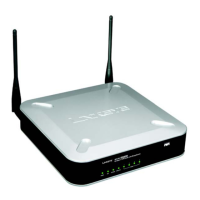Wireless-G VPN Router with RangeBooster
Figure 6-21: Wireless Security - RADIUS 29
Figure 6-22: Wireless Security - WEP 29
Figure 6-23: Wireless Tab - Wireless Network Access 30
Figure 6-24: Networked Computers 30
Figure 6-25: The Wireless Tab - Advanced Wireless Settings 31
Figure 6-26: Wireless Tab - WDS 32
Figure 6-27: The Firewall Tab - General 33
Figure 6-28: The Firewall Tab - Port Forwarding 34
Figure 6-29: The Firewall Tab - Port Triggering 35
Figure 6-30: The Firewall Tab - DMZ 36
Figure 6-31: The Firewall Tab - Access Restriction 37
Figure 6-32: The Firewall Tab - URL Filtering 38
Figure 6-33: The VPN Tab - VPN Client Access 39
Figure 6-34: The VPN Tab - VPN Client Access Warning 39
Figure 6-35: The VPN Tab - VPN Passthrough 40
Figure 6-36: The VPN Tab - IPSec VPN 41
Figure 6-37: Local Secure Group - Subnet and Remote Secure Group - IP Addr. 41
Figure 6-38: Local Secure Group - IP Address and Remote Secure Group - IP Address 42
Figure 6-39: Local Secure Group - Host and Remote Secure Group - IP Addr. 42
Figure 6-40: Local Secure Group - IP Addr. and Remote Secure Group - Any 42
Figure 6-41: Key Exchange Method - Auto (IKE) 43
Figure 6-42: Advanced Settings 43
Figure 6-43: Global NAT Traversal Advanced Settings 45
Figure 6-44: The VPN Tab - VPN Summary 46
Figure 6-45: The QoS Tab - Application-based QoS -Priority Queue 48
Figure 6-46: The QoS Tab - Application-based QoS -Bandwidth Allocation 48
Figure 6-47: The QoS Tab - Port-based QoS 49
Figure 6-48: The Administration Tab - Management 50
Figure 6-49: The Administration Tab - Log 53
Figure 6-50: The Administration Tab - Diagnostics 54
Figure 6-51: Ping Test 54
Figure 6-52: Traceroute Test 54
Figure 6-53: The Administration Tab - Factory Default 55

